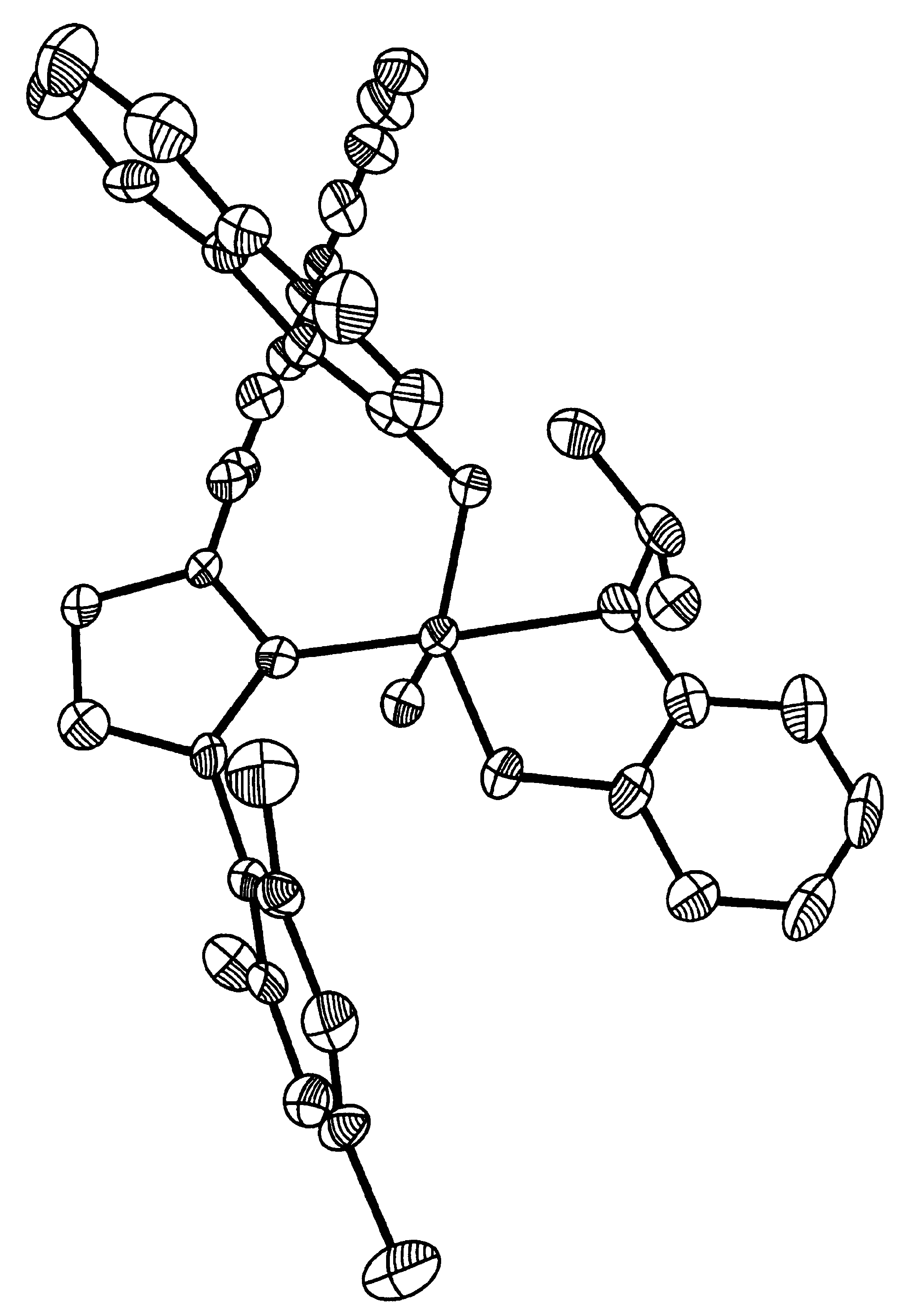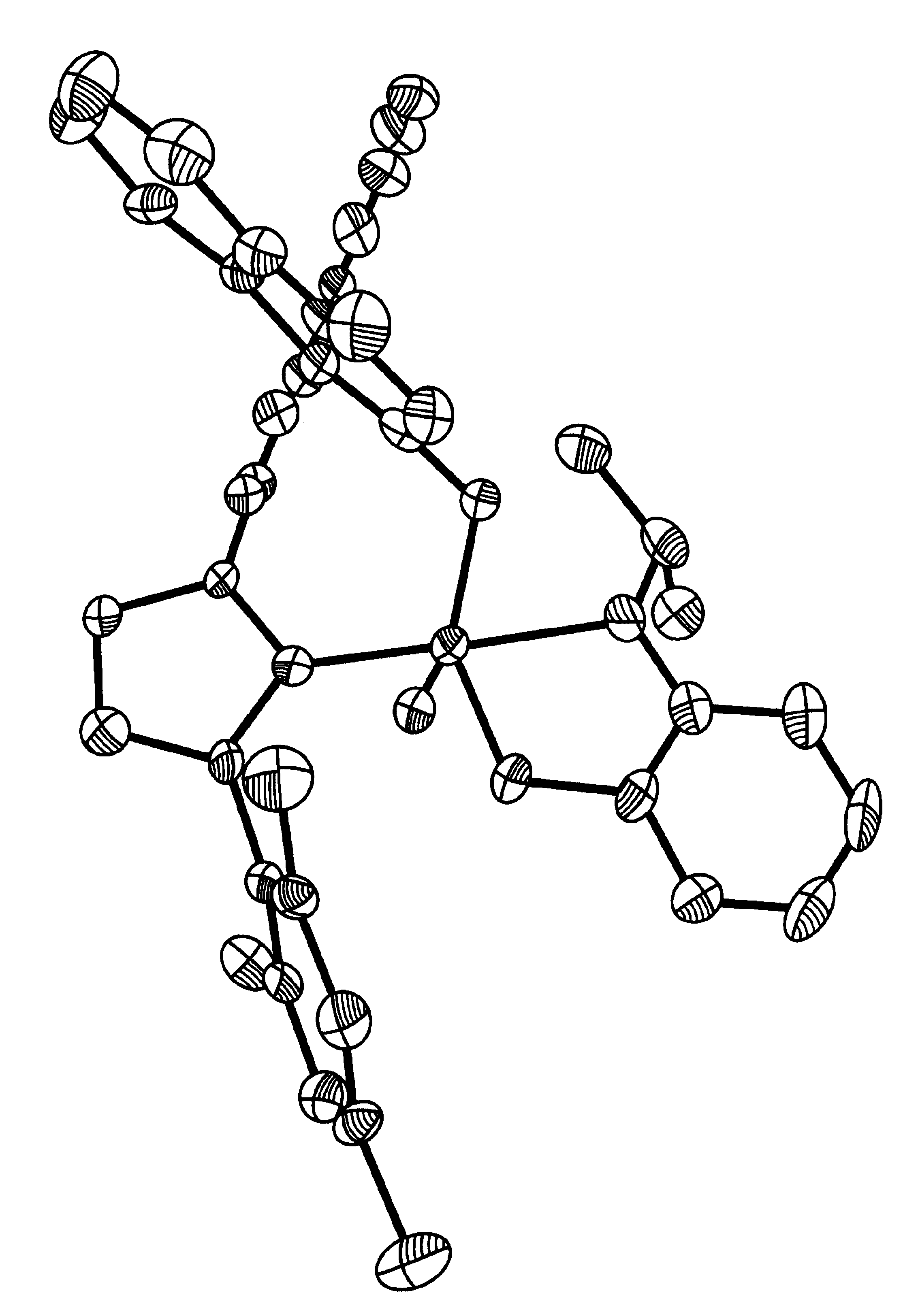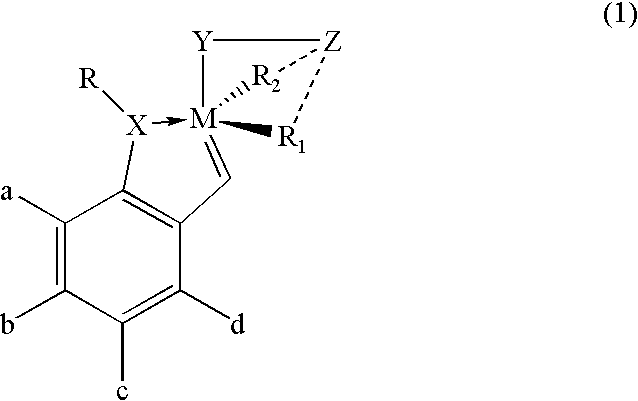Recyclable chiral metathesis catalysts
a chiral metathesis catalyst and chiral metathesis technology, applied in physical/chemical process catalysts, ruthenium organic compounds, osmonium organic compounds, etc., can solve the problems of difficult isolation of prior-art chiral metathesis catalysts from reaction products, limit their applicability to a range of substrates containing terminal alkenes, etc., and achieve high enantiomeric or stereomeric excess, easy to isolate
- Summary
- Abstract
- Description
- Claims
- Application Information
AI Technical Summary
Benefits of technology
Problems solved by technology
Method used
Image
Examples
example 1
[0038]1-Bromo-2-methoxynaphthalene. Prepared according to a literature procedure. Majetich, G.; Hicks, R.; Reister, S., J. Org. Chem. (1997), 62, 4321-4326. IR (NaCl): 3047 (w), 2972 (m), 2943 (m), 2843 (m), 1622 (s), 1596 (m), 1501 (s), 1467 (m), 1454 (m), 14.40 (w), 1353 (m), 1335 (m), 1271 (s), 1247 (w), 1219 (m), 1187 (m), 1173 (w), 1153 (w), 1064 (s), 1023 (m), 892 (m), 840 (m), 813 (m), 803 (s), 763 (m), 743 (s), 518 (m). 1H NMR (400 MHz, CDCl3): δ 8.19 (d, J=8.6 Hz, 1H), 7.75 (t, J=8.5 Hz, 2H), 7.53 (t, J=8.2 Hz, 1H), 7.36 (t, J=7.9 Hz, 1H), 7.22 (d, J=9.0 Hz, 1H), 3.98 (s, 3H). 13C NMR (100 MHz, CDCl3): δ 153.88, 133.25, 130.94, 129.09, 128.16, 127.86, 126.24, 124.43, 113.74, 108.78, 57.17. HRMS Calcd for C11H9BrO: 235.9837. Found: 235.9838. Anal. Calcd for C11H9BrO: C, 55.72; H, 3.83. Found: C, 55.66; H, 3.82.
example 2
[0039]Methyl 1-methoxynaphthoate. Prepared according to the procedures described in Hattori, T.; Hotta, H.; Suzuki, T.; Miyano, S. Bull. Chem. Soc. Jpn. (1993), 66, 613-622. IR (NaCl): 3058 (w), 2997 (w), 2948 (m), 2846 (w), 1725 (s), 1628 (m), 1597 (m), 1570 (m), 1504 (m), 1466 (m), 1445 (m), 1434 (m), 1373 (s), 1343 (s), 1279 (s), 1239 (s), 1214 (m), 1191 (m), 1153 (m), 1133 (s), 1084 (s), 1001 (m), 829 (m), 802 (m), 787 (m), 768 (s), 715 (w). 1H NMR (400 MHz, CDCl3): δ 8.30-8.26 (m, 1H), 7.87-7.84 (m, 2H), 7.62 (d, J=8.6 Hz, 1H), 7.61-7.54 (m, 2H), 4.07 (s, 3H), 3.99 (s, 3H). 13C NMR (100 MHz, CDCl3): δ 166.85, 158.44, 136.93, 128.47, 128.02, 126.83, 126.68, 123.78, 123.77, 119.34, 63.56, 52.41. HRMS Calcd for C13H12O3: 216.0786. Found: 216.0787. Anal. Calcd for C13H12O3: C, 72.21; H, 5.59. Found: C, 72.50; H, 5.52.
example 3
[0040](−)-Menthyl 1-(−)-menthyloxy-2-naphthoate was prepared by the method described by Hattori et al., Bull. Chem. Soc. Jpn. (1993), 66, 613. IR (NaCl): 3058 (w), 2954 (s), 2956 (s), 2869 (m), 1719 (s), 1625 (w), 1598 (w), 1568 (w), 1502 (w), 1457 (m), 1387 (m), 1371 (m), 1342 (m), 1319 (m), 1277 (s), 1235 (s), 1215 (m), 1203 (m), 1181 (w), 1148 (s), 1137 (s), 1098 (m), 1081 (s), 1038 (w), 1007 (w), 983 (m), 962 (m), 920 (w), 823 (w), 801 (w), 766 (m), 741 (w). 1H NMR ((400 MHz, CDCl3): δ 8.32 (d, J=8.5 Hz, 1H), 7.81 (d, J=7.7 Hz, 1H), 7.67 (d, J=8.6 Hz, 1H), 7.56-7.48 (m, 3H), 5.04 (td, J=10.9, 4.4 Hz, 1H), 4.34 (td, J=10.9, 4.2 Hz, 1H), 2.67 (quintetd, J=6.8, 2.2 Hz, 1H), 2.21-2.16 (m, 1H), 2.05 (quintetd, J=7.2, 2.7 Hz, 1H), 1.79-1.52 (m, 7H), 1.28-0.83 (m, 23H), 0.74 (d, J=6.6 Hz, 3H). 13C NMR (100 MHz, CDCl3): δ 166.77, 154.10, 136.24, 130.12, 127.86, 127.74, 126.22, 126.00, 124.56, 122.40, 121.15, 82.11, 74.59, 49.64, 47.27, 41.17, 39.97, 34.59, 34.46, 31.67, 31.61, 26.38, 25...
PUM
 Login to View More
Login to View More Abstract
Description
Claims
Application Information
 Login to View More
Login to View More - R&D
- Intellectual Property
- Life Sciences
- Materials
- Tech Scout
- Unparalleled Data Quality
- Higher Quality Content
- 60% Fewer Hallucinations
Browse by: Latest US Patents, China's latest patents, Technical Efficacy Thesaurus, Application Domain, Technology Topic, Popular Technical Reports.
© 2025 PatSnap. All rights reserved.Legal|Privacy policy|Modern Slavery Act Transparency Statement|Sitemap|About US| Contact US: help@patsnap.com



